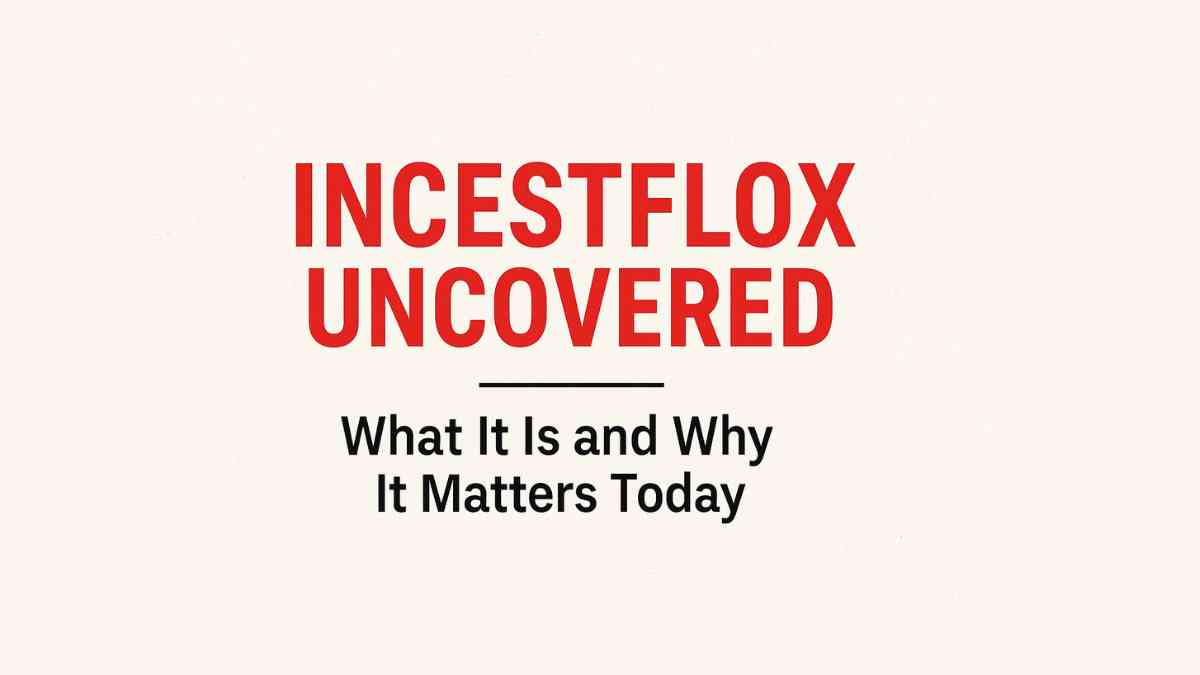Incestflox Uncovered: What It Is and Why It Matters Today

In the age of digital slang, niche communities, and viral terminology, the internet births new words at an extraordinary pace. Some fade quietly, while others stir controversy, curiosity, and culture-wide conversation. One such term capturing attention in obscure corners of the internet is Incestflox. Though it may sound provocative or alarming, much of the intrigue around this term lies in its mysterious origin and abstract usage. In this article, we explore what Incestflox is, the myths and assumptions surrounding it, and why it has found a place in today’s dialogue.
What is Incestflox?
To date, Incestflox does not have a formal dictionary definition or recognized origin in academic literature or cultural theory. It is a term that has surfaced online, likely emerging from a combination of meme culture, niche internet forums, and abstract digital commentary. The word itself seems constructed from “incest” and a suffix or code such as “flox,” possibly intended to invoke a sense of taboo mixed with absurdity or satire. Like many internet-born terms, it carries layers of meaning that depend heavily on the context in which it is used.
Some users speculate that Incestflox is a satirical term, invented to mock or critique the way online platforms sensationalize taboo topics. Others believe it may have originated as part of shock humor or experimental art movements found in certain digital subcultures. Regardless of origin, it is clear that Incestflox is not a movement, ideology, or organization — it is a term born from the eccentric, sometimes chaotic nature of online language evolution.
Introduction and Rise in Digital Culture
What makes Incestflox stand out in 2025 is how it has infiltrated niche discussions, with people asking what it is without fully understanding it. This behavior is typical in meme evolution. Like many other absurd terms before it, Incestflox may have begun as an in-joke among internet users, only to be picked up and echoed without clarification.
Unlike harmful misinformation, Incestflox doesn’t promote any concrete ideas or calls to action. Rather, it represents the fragmentation of language online and how symbols, words, or phrases can spread without intent or clarity. This kind of linguistic drift is common in decentralized communities where sarcasm, irony, and layered humor are the norm.
Separating Myths from Reality
A lot of confusion surrounding Incestflox arises because of its association with the word “incest,” a deeply sensitive and morally charged concept. However, most uses of Incestflox have little to do with actual content related to incest. In fact, the term is more often used in a surreal or ironic tone, possibly to push boundaries or question the limits of what language can do online.
It is important not to conflate the absurdity of the term with endorsement of taboo behavior. That’s a key distinction in understanding digital culture: the words people use aren’t always meant to be taken literally. Some subcultures engage with taboo words not to glorify them, but to deconstruct the weight and discomfort they carry.
Perceived Benefits and Cultural Commentary
Although the idea of “benefits” in relation to Incestflox might sound strange, there is a case to be made for its function in digital commentary. By using provocative or nonsensical terms like Incestflox, some online communities are able to:
- Challenge censorship norms
- Critique the media’s obsession with shock value
- Encourage deeper conversations about moral panic
- Push boundaries to test societal discomfort thresholds
This is not new; art, literature, and comedy have long used uncomfortable themes to force reflection. Incestflox may be yet another example of internet culture repurposing provocative language to reveal inconsistencies in how society responds to discomfort.
The Role of Internet Subcultures
The internet, especially platforms like Reddit, Tumblr, and certain Discord servers, has been a breeding ground for post-ironic terminology. In these spaces, users often deliberately invent words to make a point or express ideas that mainstream language struggles to convey. Incestflox may be born from that very tradition.
The purpose, then, is not clarity, but complexity — a kind of linguistic performance art that invites reaction, confusion, and reflection. This is why many who encounter Incestflox for the first time are unsure whether it’s a joke, a term for something real, or a critique of something bigger. And perhaps that’s the entire point.
How the Term is Used
In reviewing multiple uses across forums and blog comments, Incestflox is rarely used consistently. In some cases, it appears as a mock label for something mundane. In others, it is framed as a fictional entity or metaphor for societal decay, censorship, or familial dysfunction.
This inconsistency is part of the term’s power. Like Dadaist art or absurdist theater, its meaning may not be fixed, but fluid, shaped by the speaker and the audience at the moment of use. For readers or researchers trying to pin it down, this is both frustrating and fascinating.
Is There Any Harm?
One might ask whether a term like Incestflox poses any cultural or psychological harm. That depends on context. If used irresponsibly or misunderstood, it could trigger discomfort or be mistaken for advocacy of taboo behavior. This is why it is important to approach the topic with care, nuance, and awareness of audience.
For digital literacy advocates and educators, the existence of terms like Incestflox provides opportunities to teach about meme culture, semiotics, and online ethics. Rather than censoring such terms outright, the better path may be to understand their usage, track their spread, and explore the questions they raise.
Modern Digital Culture and the Evolution of Language
The emergence of Incestflox is not unlike the rise of words like “yeet,” “cheugy,” or “rizz.” These words often begin in marginalized or youth communities and gain traction because they encapsulate something mainstream culture can’t yet articulate.
However, unlike playful slang, Incestflox has an unsettling sound that evokes confusion and discomfort. This is likely intentional. It makes the audience pause and ask: Is this real? What does it mean? Why is this being said? In this way, it mirrors how modern art works — more concerned with the reaction than the message itself.
Why It Matters
We live in a time where information spreads fast, often with little verification or consensus. Words like Incestflox reveal how fluid our communication has become, and how meanings are negotiated rather than fixed.
For media professionals, educators, and sociologists, understanding the anatomy of such a term helps make sense of broader trends: distrust in institutions, the power of user-generated content, and the role of irony in public discourse.
Ultimately, Incestflox matters not because of what it is, but because of what it represents: the shifting landscape of language in the digital age.
Conclusion
So what is Incestflox? It is a term, a symbol, and perhaps even a critique. It may be satirical, ironic, or simply absurd. Its purpose seems less about definition and more about disruption. And in that disruption lies its relevance.
For those encountering it for the first time, the impulse may be to dismiss or react with discomfort. But just as with past waves of slang and abstract commentary, it is worth pausing to examine what lies beneath the words. In doing so, we gain insight not just into a term, but into the culture that birthed it.
Join the conversation—understand what Incestflox really means.



